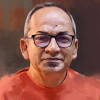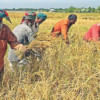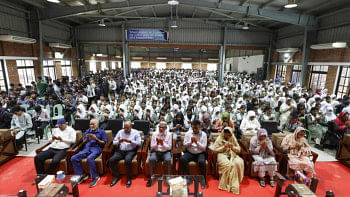Farmers kick-start a freshwater machine

Water is everywhere in and around Bangladesh, yet the lack of freshwater is one of its most pressing concerns.
On the surface of this largest river delta on the planet, the abundance of water is facing serious threats of pollution, river encroachment, flooding, and diversion or obstruction of common river waters by India and China. And beneath the surface, there develops a big hollow due to the overdraw of groundwater for irrigation and industrialisation.
The scarcity of surface water, especially in the dry season, is gradually pushing Bangladesh to depend heavily on groundwater for supply to households, farms, and industries. While the water outlook for one of the most fertile soils in the world is getting grimmer, a highly-acclaimed research holds out a big hope for Bangladesh, dispelling the commonly-shared fear of the groundwater reserve getting drier every year, and a Jakarta-like land subsidence resulting from it.

"It is a ground-breaking research for all sorts of reasons," exclaimed the lead researcher Mohammad Shamsudduha over the phone from London Thursday.
Published a month ago in the renowned journal Science, six scientists -- five of whom are Bangladeshis -- wrote in their research paper about a great water reservoir below Bangladesh that hardly runs dry. The more water is pumped out of the "Bengal Water Machine", as the researchers called it, the more water is pumped into it from the vertical and horizontal flow of freshwater from the surface and nearby lateral water sources.
The machine is being considered by geoscientists as nature's very special gift to the people in the Bengal basin, a vast sediment-filled region upon which lies Bangladesh and a part of West Bengal.
"This is a huge discovery for Bangladesh. One-third of Bangladesh is getting the benefit of nature's gift," Shamsudduha, a professor at the University College London, told The Daily Star. "It can revolutionise our farming further, as irrigation strategy could now be set scientifically."
The vast underground reservoir for freshwater was crafted slowly over thousands of years by the Ganges and the Brahmaputra that brought in tons of silt and sediment every year from as far away as the Himalayas to form the delta's spongy soil.
The Bengal Water Machine was created but not quite started until the 1980s, when Bangladesh stepped up on its rice production in the dry season. Unknowingly, millions of farmers actually kick-started the natural water system by pumping out groundwater for irrigation.
Equipped with pumps and agricultural improvements, drought-hit farmers in the north and north-west have gone for extensive irrigation that enabled Bangladesh to produce enough food each year to be nearly self-sufficient by tripling the country's rice production.
The geological formation of this Bengal basin responded strangely to the overdraw of the groundwater, with greater depletion triggering faster recharge.
"If there was no pumping, then there would have been no water machine functioning," said co-researcher Professor Kazi Matin Uddin Ahmed, who is a hydrogeologist at the University of Dhaka. "When farmers extract more groundwater, the water level falls and it creates room for additional recharge."
Boosting yields aside, the natural water system is believed to have been helping lessen flooding during monsoon seasons. "If there is no recharge, all the water would be on the surface. Then, we would have a bigger flood," said Matin.
The entire ecosystem works like a well-oiled machine: farmers pump water out and the porous soil quickly captures the rain-running-flood water before sending it down to the water machine with filtration through layers of soil on the way. Freshwater is stored in reservoirs at different depths, with the majority amount easily accessible by farmers at 100 feet below.
About 1,500-2,000 litres of groundwater are required for the production of only one kg of rice in the dry season. And the amount of groundwater that is being pumped in three months for irrigating Boro paddy is mind-blowing.
According to a World Bank study in 2021, about 32 cubic kilometres of groundwater is being extracted by the farmers every year, with which a three-story "water building" could be built over Bangladesh.
Much to the relief, the researchers have found that the Bengal Water Machine kicks in to dispel most of the overdraw concern. Freshwater amounting to 75-90 cubic kilometres were captured and pumped back into the water machine from 1988-2018. Still, there's a huge shortfall.
The withdrawal-recharge ratio is not that encouraging and consistent among all regions of Bangladesh. The rice-producing north is precariously-placed. On the other hand, the west generally experiences less rainfall than the east and it reflects on the outcome. Groundwater depletion is taking place in the west but not in the east, finds research.
"Apart from the rice-producing north, the Bengal Water Machine is also not working well in the greater Dhaka region, big cities, and industrial areas," said co-researcher Prof Anwar Zahid, also a director at the Bangladesh Water Development Board (BWDB).
"We must use the groundwater very judiciously and cautiously, looking at the data. Indiscriminate use will only make a disaster imminent," warns Anwar, theleading groundwater expert and a key resource person behind the research that spanned over 10 years.
The reason why the research is being so hailed across the globe is because of its foundation, a trove of data painstakingly put together over 30 years by the BWDB.
Over a thousand observers of the BWDB wells have been monitoring and recording the underground water levels for 60 years by now. And, the researchers used millions of groundwater measurements from 465 shallow monitoring wells (mostly at 25-70 meters depth, from where pumping for irrigation is done).
"Groundwater deeper than that level should not be used for irrigation as recharge by rainfall to that level [over 250-300 meters] takes hundreds to thousands of years," Anwar said.
The other researchers are Richard G Taylor from University College London, Md Izazul Haq and Sara Nowreen.

 For all latest news, follow The Daily Star's Google News channel.
For all latest news, follow The Daily Star's Google News channel. 





Comments